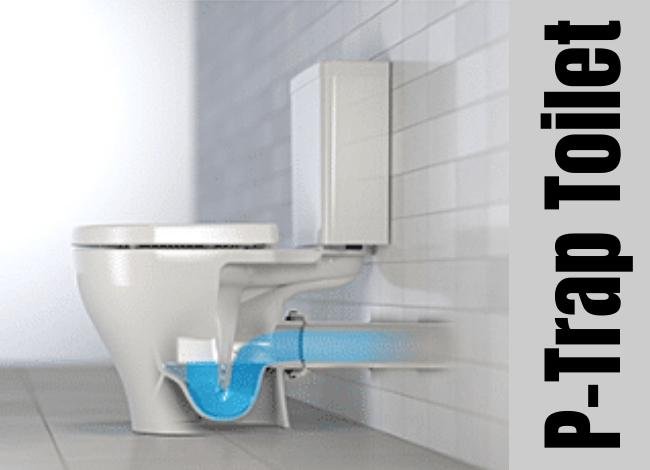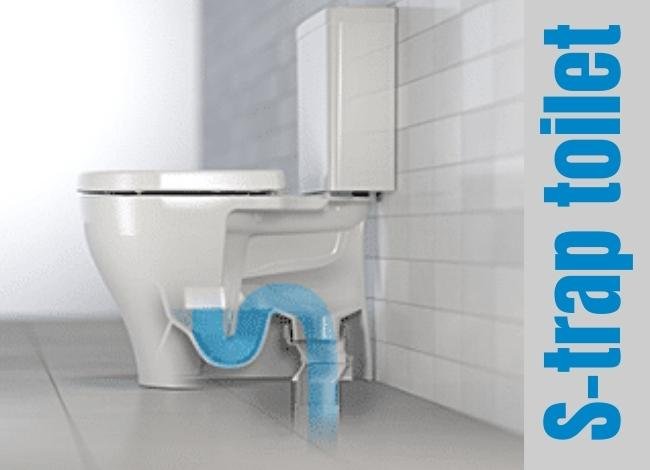Bathrooms may look simple from the outside, but behind every clean and odor-free space lies carefully designed plumbing. One of the most important elements in any toilet system is the trapway, the curved pipe that keeps harmful sewer gases from entering your bathroom. Globally, the two most widely used trapways are the S-trap and the P-trap.
The debate of S Trap vs P Trap Toilet is not just about shape—it’s about functionality, installation methods, long-term maintenance, and even compliance with modern plumbing codes. Both trap types serve the same purpose of directing waste into the drainage system, but they differ in the way they connect to plumbing lines and how effectively they control odors.
Most older homes feature S-trap toilets, where the outlet pipe connects directly through the floor. On the other hand, modern constructions and renovated bathrooms increasingly use P-trap toilets, which connect through the wall and are often paired with wall-mounted or contemporary designs.
In this article, we will explore everything you need to know about S Trap vs P Trap Toilet, including their definitions, working mechanisms, advantages, disadvantages, and which one is the best choice for your home today.
What is a P-Trap Toilet?
A P-trap toilet is designed with a P-shaped bend in its outlet pipe that connects the toilet to the drainage system. This bend holds a small but consistent amount of water, forming a natural barrier against sewer gases that could otherwise escape into the bathroom. The water seal is what makes the P-trap more reliable and hygienic compared to older designs like the S-trap.
How Does a P-Trap Work?
The P-trap functions by maintaining a constant water level inside its curve:
- Water Seal Mechanism – The curved section of the pipe traps water after every flush. This water acts as a seal, blocking unpleasant odors and harmful gases from traveling back up the pipe.
- Vent Connection – P-traps are connected to a vented pipe that leads upward through the roof. This vent balances air pressure within the drainage system and prevents siphoning, ensuring smooth and effective waste disposal.
Because of these two features, the P-trap is more effective in modern plumbing systems where efficiency and odor prevention are critical.
Advantages of P-Trap Toilets
- Better Odor Control – The water seal rarely dries out, keeping bathrooms fresh and hygienic.
- Modern Compatibility – Designed for wall-outlet installations, making it suitable for wall-mounted and back-to-wall toilets.
- Hygiene and Safety – Reduces the chances of sewer gases escaping, which can contain methane and bacteria.
- Low Maintenance – Less prone to clogging and evaporation issues compared to S-traps.
Common Uses
While the S Trap vs P Trap Toilet debate often centers around toilets, it’s worth noting that P-traps are not exclusive to them. You’ll also find P-traps installed in sinks, bathtubs, and floor drains where controlling odor and preventing siphoning are equally important.
For these reasons, plumbing professionals frequently recommend P-trap toilets for any new construction or bathroom remodel.
What is an S-Trap Toilet?
An S-trap toilet is one of the earliest trapway designs used in household plumbing. It is named after its “S”-shaped curve, which directs waste downward through the floor into the sewage system. For decades, S-traps were the most common installation in residential and commercial bathrooms, especially in houses built before modern plumbing codes were established.
How Does an S-Trap Work?
The S-trap works by using its curved design to hold water after flushing, creating a seal that helps block sewer gases. However, its mechanism is less reliable than that of the P-trap:
- Floor Outlet Connection – The outlet pipe connects directly into the floor instead of the wall.
- Siphon Action – Wastewater flows down rapidly, but sometimes too much water is pulled out of the trap, leaving it dry.
- Risk of Odor Problems – If the trap dries out, foul smells from the sewage line can easily seep back into the bathroom.
Limitations of S-Trap Toilets
- Prone to Drying Out – The siphoning effect can empty the trap, removing the protective water seal.
- Odor Issues – A dry trap allows sewer gases to escape, making bathrooms unpleasant.
- Older Design – Found mostly in older houses, as many countries have updated codes that discourage or restrict S-trap installations.
- Limited Compatibility – Works only with floor outlets, which makes it less versatile in modern bathroom layouts.
Where Are S-Trap Toilets Still Used?
Despite their drawbacks, S-trap toilets are still present in many older homes around the world, particularly in Asia and Australia. Some homeowners continue to use them because replacing an S-trap with a P-trap often requires extensive plumbing modifications.
When discussing S Trap vs P Trap Toilet, it’s clear that while S-traps served their purpose in the past, modern bathrooms overwhelmingly favor the P-trap for better hygiene and long-term efficiency.
Trap vs P Trap Toilet – Key Differences
When comparing S Trap vs P Trap Toilet, the most noticeable distinction lies in their installation method. An S-trap connects directly to the floor, while a P-trap connects to the wall. However, the differences extend far beyond where the outlet pipe is located. Let’s break down the major factors:
1. Design and Architecture
-
S-Trap Toilet – Designed for floor outlets, with pipes hidden beneath the floor. This setup was common in older homes and traditional bathrooms.
-
P-Trap Toilet – Designed for wall outlets, with a sleeker appearance. It is often used with wall-mounted and back-to-wall toilets in modern homes.
2. Shape and Functionality
-
S-Trap – Features a double curve in the shape of an “S.” While functional, it is more prone to siphoning out too much water.
-
P-Trap – Has a single, smooth P-shaped curve that holds water more consistently, making it more reliable for odor prevention.
3. Odor and Hygiene
-
S-Trap Toilet – If the trap dries out, sewer gases can enter the bathroom, causing foul smells.
-
P-Trap Toilet – Maintains a stronger water seal, reducing the chance of odors and keeping bathrooms more hygienic.
4. Compatibility with Bathroom Layouts
-
S-Trap – Works only with floor-based outlets, making it less flexible for modern designs.
-
P-Trap – Compatible with wall-based outlets and can be adapted for various toilet designs, including wall-mounted units.
5. Maintenance and Longevity
-
S-Trap Toilets – More likely to clog, dry out, and require frequent maintenance.
-
P-Trap Toilets – Easier to clean, less prone to siphoning issues, and generally last longer with fewer complications.
Quick Comparison Table
| Factor | S-Trap Toilet | P-Trap Toilet |
|---|---|---|
| Installation | Floor outlet | Wall outlet |
| Design Style | Traditional | Modern |
| Shape | S-shaped | P-shaped |
| Odor Control | Less effective | Highly effective |
| Suitability | Older homes | Modern bathrooms |
| Maintenance | Frequent issues | Low-maintenance |
Updated Information & Modern Trends
The debate of S Trap vs P Trap Toilet has become more relevant in recent years due to changes in plumbing standards, housing design, and homeowner preferences. While both systems still exist, the global trend is shifting strongly toward P-trap toilets because of their compatibility with modern infrastructure.
1. Compliance with Building Codes
Many countries have revised plumbing codes that either discourage or completely ban the installation of new S-trap toilets. This is because S-traps are more prone to odor leakage and siphoning issues. On the other hand, P-trap toilets meet current sanitation requirements and are favored by inspectors in new construction projects.
2. Rise of Modern Bathroom Designs
Today’s bathrooms often feature wall-hung toilets and compact designs, especially in apartments, hotels, and urban homes. These designs require wall-outlet systems, making the P-trap the obvious choice. The sleek, space-saving look of P-trap toilets also matches contemporary design trends.
3. Water Efficiency and Eco-Friendly Toilets
As water conservation becomes a priority, modern toilets with dual-flush systems are designed to work seamlessly with P-traps. These toilets use as little as 0.8–1.6 gallons per flush, saving water without compromising performance. Older S-trap toilets are often less efficient and may not support advanced flush technologies.
4. Hygiene and Health Benefits
A P-trap toilet provides a reliable water seal, which reduces the risk of harmful gases like methane entering your home. These gases not only cause foul odors but can also pose health risks over long-term exposure. With better odor control, P-trap toilets ensure a cleaner and healthier bathroom environment.
5. Can You Convert an S-Trap to a P-Trap?
Yes, but it usually requires professional plumbing modifications. Converting an S-trap toilet into a P-trap involves shifting the outlet from the floor to the wall, which can mean additional costs for pipe rerouting, tiling, and wall adjustments. However, many homeowners consider it a worthwhile investment during bathroom renovations because it increases home value and reduces long-term maintenance issues.
6. Smart Toilets and Technology Integration
The growing popularity of smart toilets—featuring heated seats, automatic flushing, integrated bidets, and night lights—has further boosted the demand for P-trap designs. Since most smart toilets are wall-mounted, they are compatible only with P-trap installations. This makes the P-trap not just a hygienic choice, but also a future-proof one.
Final Thoughts – Which One Should You Choose?
The choice between an S Trap vs P Trap Toilet may seem small, but it can have a big impact on your bathroom’s hygiene, efficiency, and long-term maintenance. Both systems serve the same fundamental purpose, yet they cater to different bathroom layouts and building requirements.
- S-Trap Toilets – Best suited for older homes where the drain outlet is already located on the floor. They can still perform well if properly maintained, but they are more likely to develop odor issues due to siphoning and evaporation.
- P-Trap Toilets – The preferred option for modern bathrooms. They are compatible with wall outlets, prevent foul smells effectively, and support contemporary toilet designs, including wall-hung and smart toilets.
Expert Recommendation
If you are building a new bathroom or renovating an existing one, plumbing experts strongly recommend installing a P-trap toilet. Not only does it provide a cleaner and odor-free environment, but it also ensures compliance with modern plumbing standards.
Example of a Modern P-Trap Toilet
One popular model is the Signature Hardware Ebler P-Trap Toilet:
- Type: Two-piece toilet
- Flush: Dual flush (0.8/1.6 GPF)
- Material: Vitreous china
- Height: ADA-compliant for comfort
- Design: Elongated bowl with a modern look
- Toilet Seat: Included
This kind of design reflects why P-trap toilets are becoming the global standard—they combine style, efficiency, and hygiene.
Conclusion
In the S Trap vs P Trap Toilet debate, the verdict is clear:
- S-traps belong to older construction styles and are less efficient at preventing odors.
- P-traps are modern, hygienic, and versatile, making them the best choice for today’s homes and future bathroom upgrades.
If you want a long-lasting, odor-free, and regulation-friendly solution, the P-trap toilet is the way to go.
Hi, this is Robert Crossan, the owner of this website, has 17 years of experience in the installation, maintenance, and repair of toilets and plumbing systems. After completing the Level 2 Basic Plumbing course in 2005, I started working in both domestic and commercial buildings as a professional plumber. So I can figure out the core difference between different toilet models and brands. It also helped me monitor their work performance and setbacks.